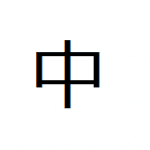 Naka in Japanese means middle. The character (shown at left) is one of the easiest to remember of the gazillion or so that there are to learn.
Naka in Japanese means middle. The character (shown at left) is one of the easiest to remember of the gazillion or so that there are to learn.
Shifting gears and going back to sake, most readers likely recall that sake ferments for typically 18 to 35 days, and after that has run its course, the moromi (mash) is a thick white liquid that is basically sake with a suspension of rice solids that did not or could not ferment. These need to be filtered away to yield clear or slightly amber sake.
Yes, in truth, this is a filtration. And filter is a perfectly valid term. But I prefer to use the term “pressed,” as this eliminates confusion (or at least I think it does) since there is another filtration performed with charcoal or a solid-state ceramic filter later in the process. Also, the term “pressing” is a closer translation of the original Japanese term “shibori” used in reference to the step of separating the sake from the suspended rice solids.
Terminology notwithstanding, this is usually done by machine. The moromi is pumped from the tank 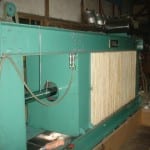 into a long accordion-like contraption, in between alternating mesh panels and inflatable baloon-like membranes. When the membranes are inflated, the moromi is forced through the mesh, and the sake goes through leaving the rice particles behind.
into a long accordion-like contraption, in between alternating mesh panels and inflatable baloon-like membranes. When the membranes are inflated, the moromi is forced through the mesh, and the sake goes through leaving the rice particles behind.
These machines do an awesome job, and are used for perhaps 99 percent of all sake made. But as hydraulics were not exactly in their heyday in the 1500s, this is not the traditional way that sake was pressed.
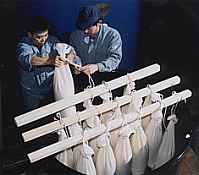 Traditionally and historically there were two ways, and both are still used today. One was to pour the moromi into cloth bags about a meter long and lay those bags inside of a big wooden box called a fune. The lid of the box, slightly smaller than the opening, was then cranked down into the box to squeeze the sake out and leave the rice solids neatly in the bags. Well, sorta neatly; cleanup is still a hassle. While less common, pressing using a fune is still done today for much premium sake, and doing so leads to slightly more elegant, refined and lively sake.
Traditionally and historically there were two ways, and both are still used today. One was to pour the moromi into cloth bags about a meter long and lay those bags inside of a big wooden box called a fune. The lid of the box, slightly smaller than the opening, was then cranked down into the box to squeeze the sake out and leave the rice solids neatly in the bags. Well, sorta neatly; cleanup is still a hassle. While less common, pressing using a fune is still done today for much premium sake, and doing so leads to slightly more elegant, refined and lively sake.
The other way is to pour the moromi into the same bags, but then tie them off, and just let the sake drip out, with no pressure at all applied. This method is called shizuku, which means drip, and, not surprisingly, sake pressed in this way is yet even more elegant, refined and lively.
However: in doing it either one of these two traditional ways, there are a myriad of complications and conditions. Most relevant to our discussion here, the stuff that drips out at the beginning is different from what drips out at the end, and that is different from what comes out in the middle. And there are terms for each of these; but the problem is that these terms are not legally defined or regulated, and there is some variation from brewer to brewer – more than there needs to be, truth be told.
However, the most useful point related to all of this is this: of all the sake that comes running out of the box or the bags, the middle one-third or so is considered the best. And it is often marketed as such. But here is the crux of the issue: the terms used to indicate this will vary a bit.
 In particular, there are three terms that are used more or less interchangeably, but all include the
In particular, there are three terms that are used more or less interchangeably, but all include the 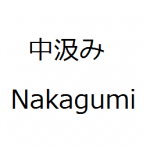 character for naka- or middle. Naka-dori (“taken from the middle”), naka-gumi (“scooped from the middle”) and naka-dare (“dripped out of the middle”) all refer to the middle third of the pressing. So if naka is in there somewhere, you’re drinking the best part of the pressing. Just remember that and you’re golden.
character for naka- or middle. Naka-dori (“taken from the middle”), naka-gumi (“scooped from the middle”) and naka-dare (“dripped out of the middle”) all refer to the middle third of the pressing. So if naka is in there somewhere, you’re drinking the best part of the pressing. Just remember that and you’re golden.
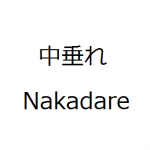 By the way, the first third is called “ara-bashiri,” or “rough run,” and is usually rougher and brasher than the smoother middle part. But this term too is sometimes used outside of this context, and at least in one case is used to simply imply fresh youth and generally sake made in the early part of the brewing season (one such case is Masumi from Nagano).
By the way, the first third is called “ara-bashiri,” or “rough run,” and is usually rougher and brasher than the smoother middle part. But this term too is sometimes used outside of this context, and at least in one case is used to simply imply fresh youth and generally sake made in the early part of the brewing season (one such case is Masumi from Nagano).
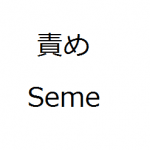 And the last third is called “seme,” and in reality the last part of the pressing is often thin and worn out. It is often mixed in with cheaper sake. I used to confidently say that no brewer would ever write “seme” on the bottle and market it as such. But never put anything past the sake world: I know of at least two brewers that proudly write seme on the bottle, as if to confidently boast, “even are dregs are so damn good that you’re going to love it!”
And the last third is called “seme,” and in reality the last part of the pressing is often thin and worn out. It is often mixed in with cheaper sake. I used to confidently say that no brewer would ever write “seme” on the bottle and market it as such. But never put anything past the sake world: I know of at least two brewers that proudly write seme on the bottle, as if to confidently boast, “even are dregs are so damn good that you’re going to love it!”
Remember that this term is not legally regulated or defined, so who knows for sure just when it came out or how it was pressed.
These terms do not so much apply to sake pressed by machine, but more to sake pressed in the old, 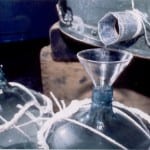 traditional methods using the fune (box) or shizuku (drip) methods. However, at the risk of beating a dead sake-horse, there is some variance and vagueness owing to the lack of an official definition.
traditional methods using the fune (box) or shizuku (drip) methods. However, at the risk of beating a dead sake-horse, there is some variance and vagueness owing to the lack of an official definition.
And, not surprisingly, there is more. Let us save that for the next time. But just remember that naka-dori = naka-gumi = naka-dare, and that they all = good sake, and that = you taking your sake experience to a slightly higher level.
Such is The Middle Way of sake.




